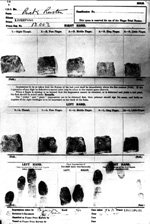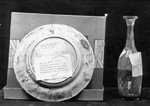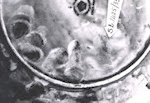Evidence of Finger-prints
In his Text Book of Medical Jurisprudence and Toxicology (1915) John Glaister Senior outlines the history of the fingerprint method, referring to the work of Sir William Herschel and Sir Francis Galton. He notes that Dr Henry Faulds (1843-1930) [a graduate of the University of Glasgow] was the first to suggest the finger-bulb markings as a means of identification of criminals. In an article published in Nature in 1880 entitled 'On the Skin-Furrows of the Hand' Faulds wrote that 'when bloody finger-marks or impressions on clay, glass etc., exist, they may lead to the scientific identification of criminals, the pattern was unique.'
It was however, Sir Edward Henry's (1850-1931) fingerprint system which became accepted as the 'sole official method employed in the identification of habitual criminals in this country.' Henry's system relied upon dividing finger-tip impressions into four types: arches, loops, whorls and composites. According to Glaister 'the essential features of this system are the impressions which are taken from the bulbs of the fingers and thumbs. It is well known that the skin these situations is thrown into ridges and hollows of various patterns, from which impressions may be taken on paper or cardboard by means of printers' ink, which can be delineated by the aid of a hand-lens, or may be enlarged by photographic processes. These markings maintain their individual peculiarities in each person from infancy to old age, and with probable exceptions, in which habitual friction or pressure, or wounds with resultant scars may affect their integrity, they also retain their definition and singularity.'
Official forms were issued for the recording of fingerprints of criminals. The form was used for the purpose of discovering whether a suspected prisoner already has a criminal record, as well as imprints found on articles at a crime scene.
The Ruxton Case
 |
In 1936, Dr Buck Ruxton was charged with the double murder of his wife and house maid, in his house at 2 Dalton Square, Lancaster in 1935. Ruxton dismembered their bodies and then disposed of them throughout the countryside in Moffat. Buck Ruxton's Fingerprint Form. Ruxton's prints were taken in Liverpool Prison, 17th October, 1935. |
 |
Photograph of a plate and a decanter from the Sitting-Room (Lounge) Cupboard, 2 Dalton Square. Ref: GUA FM/2A/25/26 Several fingerprints are indicated by arrows. |
 |
Plate from the Drawing-Room Cabinet, 2 Dalton Square Ref: GUA FM/2A/25/80 Fingerprints were matched from here to the remains found in Moffat. |
Publications
- Faulds, Henry (1880) 'On the Skin-Furrows of the Hand', Nature: 22, 605.
- Faulds, Henry (1905) Guide to Finger-Print Identification (Hanley: Wood, Mitchell & Co.).
- Faulds, Henry (1911) Dactylography: A Journal Devoted to the Science of Finger Print Identification (Halifax: Milner & Co.).
- Faulds, Henry (1912) Dactylography: A Journal Devoted to the Science of Finger Print Identification (Halifax: Milner & Co.).
- Faulds, Henry (1915) How the English Fingerprint Method Arose (Hanley: Wood, Mitchell & Co.).
- Faulds, Henry (1917) The Hidden Hand: A Contribution to the History of Finger Prints (Hanley: Wood, Mitchell & Co.).
- Faulds, Henry (1920) The Hidden Hand: A Contribution to the History of Finger Prints (Hanley: Wood, Mitchell & Co.).
- Faulds, Henry (1920) The Hidden Hand: Vestigia Nulla Retrorsum: With Appendix (Hanley: Wood, Mitchell & Co.).
- Faulds, Henry (1923) A Manual of Practical Dactylography: A Work For the Use of Students of the Finger-Print Method of Identification (London: The Police Review Publishing Co.).
- Faulds, Henry (1926) Was Sir E.R. Henry the Originator of the Finger Print System? (Webberley: Hanley).
- Faulds, Henry & Wilton, George W. (1955) Fingerprints: Fifty Years of Injustice [On the Part Played by Henry Faulds in the Development of Fingerprint Identification] (Galashiels: A. Walker & Son).
- Glaister, John (1915) A Text-Book of Medical Jurisprudence and Toxicology (Edinburgh: E. & S. Livingstone).
- Henry, E.R. (1896) Bengal Police: Instructions for Classifying and Deciphering Finger Impressions and for Describing Them with Sufficient Exactness to Enable Comparison of the Description with the Original Impression to be Satisfactorily Made. (India?: s.n.).
- Henry, E.R. (1900) Classification and Uses of Finger Prints (London: HM Stationery Office).
- Henry, E.R. (1901) Classification and Uses of Finger Prints (London: HM Stationery Office).
- Henry, E.R. (1905) Classification and Uses of Finger Prints (London: HM Stationery Office).
- Henry, E.R. (1913) Classification and Uses of Finger Prints (London: HM Stationery Office).
- Henry, E.R. (1922) Classification and Uses of Finger Prints (London: HM Stationery Office).
- Henry, E.R. (1928) Classification and Uses of Finger Prints (London: HM Stationery Office).
- Henry, E.R. (1934) Classification and Uses of Finger Prints (London: HM Stationery Office).
- Henry, E.R. (1937) Classification and Uses of Finger Prints (London: HM Stationery Office).
- Roland, J.H.S. (1959) The Finger-Print Man: The Story of Sir Edward Henry (London: Lutterworth).
- Wilton, G.W. (1938) Fingerprints: History, Law and Romance, etc. (London: W. Hodge & Co.).
- Wilton, G.W. (1951) Fingerprints: Scotland Yard and Henry Faulds (Edinburgh: W. Green & Son).
- Wilton, G.W. (1957) Fingerprints: Scotland Yard Ruxton Trial Revelations, with a Renewed Appeal to the British Government for the Daughters of Faulds ( North Berwick.: Tantallon Press).
- Wilton, G.W. (1963) Fingerprints: Swan Song of Old "Dr Fingerprints" [Dr Henry Faulds], Victory Won (North Berwick: Tantallon Press).

